This article has been accepted for publication in a future issue of this journal, but has not been fully edited. Content may change prior to final publication. Citation information: DOI 10.1109/TAC.2017.2700384, IEEE
Transactions on Automatic Control
0018-9286 (c) 2016 IEEE. Personal use is permitted, but republication/redistribution requires IEEE permission. See http://www.ieee.org/publications_standards/publications/rights/index.html for more information.
1Event-TriggeredGlobalRobustOutputRegulationforaClassofNonlinearSystemsWeiLiu,Member,IEEEandJieHuang,Fellow,IEEEAbstract—Thisnotestudiestheglobalrobustoutputregulationproblemforaclassofnonlinearsystemsbyanoutput-basedevent-triggeredcontrollaw.First,weconverttheproblemintotheevent-triggeredglobalrobuststabilizationproblemofawelldefinedaugmentedsystembasedontheinternalmodelapproach.Then,wedesignanoutput-basedevent-triggeredcontrollawtogetherwithanoutput-basedevent-triggeredmechanismtosolvethestabilizationproblem,whichinturnleadstothesolutiontotheoriginalproblembyanoutput-basedevent-triggeredcontrollaw.Finally,weillustrateourapproachbyanexample.IndexTerms—Event-triggeredcontrol,nonlinearsystems,out-putregulation,robustcontrol.I.INTRODUCTIONTherobustoutputregulationproblemhasbeenoneofthebasicandimportantcontrolproblemssince1970s.Theproblemaimstodesignafeedbackcontrollawforanun-certainsystemsothattheoutputoftheclosed-loopsystemasymptoticallytrackssomereferenceinputsinthepresenceofsomeexternaldisturbances,whereboththereferenceinputsandtheexternaldisturbancesaregeneratedbyanexosystem.Theproblemhasbeenstudiedforbothlinearuncertainsystemsin,say,[4],[7],[8],andnonlinearuncertainsystemsin,say,[3],[14],[15],[16].Inthisnote,wewillfurtherstudytheglobalrobustoutputregulationproblemfornonlinearsystemsinnormalformwithunityrelativedegreebytheoutput-basedevent-triggeredcontrollaw.Inpractice,acontrollawisoftenimplementedinadig-italplatform.Oneapproachisthetraditionalsampled-dataimplementation[2],[9],wherethecontrolactuationupdatesperiodicallyevenafterthesystemhasachievedthecontrolgoalwithsufficientaccuracy.Incontrast,theevent-triggeredcontrolapproachgeneratesthesamplingsandcontrolactuationwhenthesystemstateoroutputdeviatesmorethanacertainthresholdfromanacceptablevalue[11].Thustheevent-triggeredcontrolapproachismoreefficientinutilizingthelim-itedcontroltaskexecutioncapabilitiesandenergyresources.Animportantissuewiththeevent-triggeredcontrolistoguaranteetheexistenceofapositivedwellingtimetopreventtheso-calledZenobehavior,i.e.,theexecutiontimesbecomearbitrarilycloseandresultinanaccumulationpoint[25].TheThisworkhasbeensupportedbytheResearchGrantsCounciloftheHongKongSpecialAdministrationRegionundergrantNo.14200515.WeiLiuandJieHuangarewiththeDepartmentofMechanicalandAutoma-tionEngineering,TheChineseUniversityofHongKong,Shatin,NewTerrito-ries,HongKong.E-mail:wliu@mae.cuhk.edu.hk,jhuang@mae.cuhk.edu.hkCorrespondingauthor:JieHuang.Themainresultofthispaperwithoutanyproofwillbepresentedatthe20thWorldCongressoftheInternationalFederationofAutomaticControl,July9-14,2017,Toulouse,France.event-triggeredcontrolproblemshavebeenfirststudiedforlinearsystems[6],[11],[19],[26].Specifically,reference[11]gaveanintroductiontotheevent-triggeredcontrolandstudiedthestabilizationproblemforaclassoflinearsystemsbyastate-feedbackevent-triggeredcontrollaw.Reference[26]furtherstudiedthestabilizationproblemforaclassofLTIsystemsbyanoutput-basedevent-triggeredcontrollaw.In[6],anoutput-basedevent-triggeredcontrollawwasproposedtoguaranteetheclosed-loopstabilityandtheL1-performanceforaclassoflinearsystems.Reference[19]furtherstudiedtherobustpracticaloutputregulationproblemforaclassoflinearuncertainminimum-phasesystemsbyanoutput-basedevent-triggeredcontrollaw.Recently,theevent-triggeredcontrolproblemshavealsobeenstudiedforvariousnonlinearsys-tems.Forexample,undertheassumptionoftheinput-to-statestabilitywithrespecttothemeasurementerror,reference[25]proposedastate-basedevent-triggeredcontrollawtosolvethestabilizationproblemforaclassofnonlinearsystems.In[18],byusingthecyclicsmallgaintheorem,therobuststabilizationproblemforaclassofnonlinearsystemssubjecttoexternaldisturbanceswassolvedbyastate-basedevent-triggeredcontrollaw.Reference[27]studiedtheasymptotictrackingproblemforaclassofnonlinearsystemsbyastate-basedevent-triggeredcontrollawanditwasshownthatthetrackingerrorwasuniformlyultimatelybounded.Reference[5]analyzedthestabilityandLp-performanceforaclassofnonlinearsystemsbasedonanoutputfeedbackevent-triggeredcontrollaw.In[1],anoutput-basedeventtriggeredcontrollawwasproposedtosolvethestabilizationproblemfornonlinearsystems.Someothereffortscanbefoundin[10],[23],[28],[31].Sofar,theevent-triggeredcontrolproblemsfornonlinearsystemsaremainlylimitedtostabilizationproblem[1],[10],[18],[23],[25],ortrackingproblem[27],[28].Theevent-triggeredglobalrobustoutputregulationproblemfornonlinearsystemshasneverbeenstudiedbefore.Comparedwiththoseexistingresults,ourproblemismorechallenginginthefol-lowingthreeways.First,weneedtoaddressboththetrackingproblemanddisturbancerejectionproblemsimultaneously.Second,weneedtohandleuncertainparametersthatbelongtosomearbitrarilylargeprescribedcompactset.Third,ourcontrollawisadynamicoutputfeedbackcontrollaw.Toimplementsuchacontrollawinadigitalplatform,weneedtoseekaspecificformofcontrollawandsamplenotonlytheoutputoftheplantbutalsothestateofthedynamiccompensator.Thus,thestabilityanalysisoftheclosed-loopsystemismorechallengingthanthestaticstateorstaticoutputfeedbackcase.Toovercomethesechallenges,wecombinethe�
This article has been accepted for publication in a future issue of this journal, but has not been fully edited. Content may change prior to final publication. Citation information: DOI 10.1109/TAC.2017.2700384, IEEE
Transactions on Automatic Control
0018-9286 (c) 2016 IEEE. Personal use is permitted, but republication/redistribution requires IEEE permission. See http://www.ieee.org/publications_standards/publications/rights/index.html for more information.
2internalmodelapproachwithanoutput-basedevent-triggeredmechanism.Thisevent-triggeredmechanismcontainsadesignparameterwhichnotonlydictatestheultimateboundofthetrackingerroroftheclosed-loopsystem,butalsothefrequencyofthetriggeringevents.Itturnsoutthatthiscontrollawtogetherwiththeevent-triggeredmechanismleadstothepracticalsolutiontoourprobleminthesensethatthesteady-statetrackingerroroftheclosed-loopsystemcanbemadearbitrarilysmallwithoutincurringtheZenobehaviorintheevent-triggeredmechanism.Notation.Foranycolumnvectorsai,i=1,...,s,denotecol(a1,...,as)=[aT1,...,aTs]T.∥x∥denotestheEuclideannormofvectorx.∥A∥denotestheinducednormofmatrixAbytheEuclideannorm.Z+denotesthesetofallnonnegativeintegers.Thebaseofthenaturallogarithmisdenotedbye.λmax(A)andλmin(A)denotethemaximumeigenvalueandtheminimumeigenvalueofasymmetricrealmatrixA,respectively.II.PROBLEMFORMULATIONANDPRELIMINARIESConsideraclassofnonlinearsystemsasfollows˙z=f(z,y,v,w)˙y=g(z,y,v,w)+b(w)ue=y−q(v,w)(1)where(z,y)∈Rn×Risthestate,e∈Ristheerroroutput,u∈Ristheinput,w∈Rnwisanuncertainconstantvector,andv(t)∈Rnvisanexogenoussignalrepresentingbothreferenceinputandexternaldisturbance.Itisassumedthatv(t)isgeneratedbyalinearexosystemasfollows˙v=Sv,y0=q(v,w).(2)Allfunctionsin(1)and(2)areassumedtobesufficientlysmooth,andsatisfyf(0,0,0,w)=0,g(0,0,0,w)=0,q(0,w)=0forallw∈Rnw.System(1)takesthesameformasthatin[29]andiscalledanonlinearsysteminnormalformwithunityrelativedegree.Ourcontrollawisofthefollowingform:u(t)=ˆf(e(tk))+Ψη(tk)˙η(t)=Mη(t)+Nu(t),t∈[tk,tk+1),k∈Z+(3)whereˆf(·)issomenonlinearfunction,η∈Rsforsomeintegers,Ψ,MandNaresomematricestobespecifiedlater,tkdenotesthetriggeringtimeinstantwitht0=0,andisgeneratedbythefollowingso-calledevent-triggeredmechanismtk+1=inf{t>tk|h(˜e(t),˜η(t),e(t))≥δ}(4)whereδ>0issomeconstant,h(·)issomenonlinearfunction,and˜e(t)=e(tk)−e(t)˜η(t)=η(tk)−η(t)(5)foranyt∈[tk,tk+1)withk∈Z+.Remark2.1:Denotethemaximallydefinedintervalforthesolutionxc(t)=col(z(t),η(t),y(t))oftheclosed-loopsystemcomposedof(1)and(3)withthetriggeringmechanism(4)by[0,TM)with0tk.Tomakeoursystemwellbehaved,weneedtomakesurethatourcontrollawtogetherwiththetriggeringmechanismwillguaranteeTM=∞,thusrulingouttheZenobehavior.Remark2.2:Thecontrollaw(3)iscalledadynamicoutput-basedevent-triggeredcontrollawandtheη-subsystemof(3)istheso-calledinternalmodelwhichwillbeintroducedlaterbasedontheresultin[29].Itisnotedthatthiscontrollawtakessomespecificforminthatthefirstequationislinearinη(tk)andthesecondequationislinearinη(t)andu(t).Thisspecificformlendsitselftothefollowingpiecewiseconstantimplementation:u(t)=ˆf(e(tk))+Ψη(tk)η(tk+1)=eM(tk+1tk)η(tk)+N(ˆf(e(tk))+Ψη(tk))∫tk+1tkeM(tk+1)dτ(6)foranyt∈[tk,tk+1)withk∈S.Itisworthmentioningthat,asopposedtothetraditionalperiodicsamplingtechniquein,say,[2],in(6),thesamplingisaperiodicandthesequence{tk}k2Sisdeterminedbytheoutput-basedevent-triggeredmechanism(4).Itisalsonotedthat(3)ismorecomplexthanthestaticstate-basedevent-triggeredcontrollawsin[18],[21],[25],[27],sinceweneedtosamplenotonlytheerroroutputoftheplantbutalsothestateoftheinternalmodel.Similarly,ourevent-triggeredmechanism(4)isalsomorecomplexsinceitnotonlydependson˜e(t),e(t),butalso˜η(t).Asaresult,itismorechallengingtoanalyzethestabilityoftheclosed-loopsystemandpreventZenobehaviorfromhappening.Nowwedescribeourproblemasfollows.Problem2.1:Giventheplant(1),theexosystem(2),somecompactsubsetsV⊂RnvandW⊂Rnwwith0∈Wand0∈V,andanyϵ>0,designacontrollawoftheform(3)andanevent-triggeredmechanismoftheform(4)suchthattheresultingclosed-loopsystemhasthefollowingproperties:foranyv∈V,w∈W,andanyinitialstatesz(0),y(0),η(0),thetrajectoryoftheclosed-loopsystemexistsandisboundedforallt≥0;limt!1sup|e(t)|≤ϵ.Remark2.3:WecallProblem2.1astheevent-triggeredglobalrobustpracticaloutputregulationproblem.WecallacontrollawthatsolvesProblem2.1asapracticalsolutiontotheglobalrobustoutputregulationproblem.Problem2.1is�
This article has been accepted for publication in a future issue of this journal, but has not been fully edited. Content may change prior to final publication. Citation information: DOI 10.1109/TAC.2017.2700384, IEEE
Transactions on Automatic Control
0018-9286 (c) 2016 IEEE. Personal use is permitted, but republication/redistribution requires IEEE permission. See http://www.ieee.org/publications_standards/publications/rights/index.html for more information.
3morechallengingthantheproblemin[29]inthefollowingthreeaspects.First,weneedtodesignbothanevent-triggeredmechanismandapiecewiseconstantcontrollaw.Second,thestabilitybehaviorofourclosed-loopsystemismorecomplexsincetheclosed-loopsystemsisahybridsystem.Third,inordertopreventtheZenobehavior,weneedtoguaranteeTM=∞,i.e.,thesolutionoftheclosed-loopsystemexistsforallt∈[0,∞).Tosolveourproblem,asin[29],weneedtofirstintroducetheinternalmodelfor(1)and(2),andformtheso-calledaugmentedsystem.Forthispurpose,wefirstintroducesomestandardassumptionswhichcanalsobefoundin[29],[30].Assumption2.1:Theexosystemisneutrallystable,i.e.,alltheeigenvaluesofSaresemi-simplewithzerorealparts.Assumption2.2:b(w)isacontinuousfunctionandsatisfiesb(w)>0forallw∈Rnw.Remark2.4:UnderAssumption2.2,foranyknowncom-pactsubsetW⊆Rnw,therealwaysexistsomeknownpositivenumbersbmandbMsuchthat,bm≤b(w)≤bMforallw∈W.Sinceb(w)u=(−b(w))(−u)=ˆb(w)ˆuwithˆb(w)=−b(w)andˆu=−u.Ifb(w)<0forallw∈Rnw,bychangingutoˆu,thenˆb(w)willstillsatisfyAssumption2.2.Assumption2.3:Thereexistsagloballydefinedsmoothfunctionz:Rnv×Rnw7→Rnwithz(0,w)=0suchthat∂z(v,w)∂vSv=f(z(v,w),q(v,w),v,w)(7)forall(v,w)∈Rnv×Rnw.Remark2.5:UnderAssumption2.3,lety(v,w)=q(v,w)u(v,w)=b1(w)(∂q(v,w)∂vSv−g(z(v,w),q(v,w),v,w)).Then,z(v,w),y(v,w)andu(v,w)arethesolutiontotheregulatorequationsassociatedwith(1)and(2)[3],[13],[29].Itisknownthatthesolvabilityoftheregulatorequationsisanecessaryconditionforthesolvabilityoftheoutputregulationproblem.Thesolutionoftheregulatorequationsprovidesthenecessaryfeedforwardcontrolinformationtothecontroller.Nevertheless,u(v,w)cannotbedirectlyusedfordesigningfeedbackcontrollawasitdependsontheexogenoussignalvandtheunknownparameterw.Weneedtodesignadynamiccompensatorcalledinternalmodelwhichcanasymptoticallyprovidetheinformationofu(v,w).Fortheexistenceofalinearinternalmodel,weneedonemoreassumption.Assumption2.4:Thefunctionu(v,w)isapolynomialinvwithcoefficientsdependingonw.Remark2.6:Asremarkedin[29],underAssumptions2.1to2.4,thereexistsanintegersandarealcoefficientpolynomialP(λ)=λs−ϱ1−ϱ2λ−···−ϱsλs1(8)whoserootsarealldistinctwithzerorealpart,suchthat,foralltrajectoriesv(t)oftheexosystem(2)andallw∈W,u(v,w)satisfiesdsu(v,w)dts=ϱ1u(v,w)+ϱ2du(v,w)dt+···+ϱsds1u(v,w)dts1.(9)LetΦ=01···0............00···1ϱ1ϱ2···ϱs,Γ=10...0T.Since(Γ,Φ)isobservableandtheeigenvaluesofΦhavezerorealpart,foranycontrollablepair(M,N)withM∈RssaHurwitzmatrixandN∈Rs1acolumnvector,thereisauniquenonsingularmatrixTsatisfyingthefollowingSylvesterequation:TΦ−MT=NΓ.(10)WefurtherletΨ=ΓT1andθ(v,w)=Tcol(u(v,w),˙u(v,w),···,u(s1)(v,w)).Thenitcanbeverifiedthatθ(v,w)hasthefollowingproper-ties:u(v,w)=Ψθ(v,w)∂θ(v,w)∂vSv=(M+NΨ)θ(v,w).(11)Moreover,defineadynamiccompensatorasfollows[22]:˙η=Mη+Nu.(12)Intheliterature[3],[13],[22],thedynamiccompensator(12)iscalledalinearinternalmodelof(1),whichisusedtorepro-ducethefunctionθ(v,w)asymptotically,thusasymptoticallyprovidingtheinformationofthefunctionu(v,w).Remark2.7:Assumptions2.1-2.4havebeenusedin[29],[30]andotherliteraturefordealingwiththeglobalrobustoutputregulationproblemforthesamesystemas(1).Itmayworthfurtherdiscussingtherationalityoftheseassumptionsandthepossibilityofrelaxingthem:UnderAssumption2.1,foranyv(0)∈V0withV0beingsomeknowncompactset,thereexistsanothercompactsetVsuchthatv(t)∈Vforallt≥0.Itispossibletorelaxthisassumptionbyconsideringthenonlinearexosystemaswedidin[20].Assumption2.2assumesthatthesignofthecontrolgainb(w)isknown.Itisalsopossibletofurtherconsiderthecasewherethesignofthecontrolgainisunknownbyusingtheso-calledNussbaumgaintechniqueaswedidin[29].Assumption2.3isanecessaryconditionforthesolvabil-ityoftheregulatorequationsandthusitisanecessaryconditionforthesolvabilityoftheoutputregulationproblemforthesystem(1).AsnotedinRemark2.6,Assumption2.4guaranteestheexistenceofthelinearinternalmodel(12).Itispossibletofurtherrelaxthisassumptionbyconsideringthenonlinearinternalmodelaswedidin[20].Thecompositionoftheoriginalplant(1)andtheinternalmodel(12)iscalledtheaugmentedsystem.Next,wewillshowthattheoutputregulationproblemof(1)canbeconvertedtothestabilizationproblemoftheaugmentedsystem.For�
This article has been accepted for publication in a future issue of this journal, but has not been fully edited. Content may change prior to final publication. Citation information: DOI 10.1109/TAC.2017.2700384, IEEE
Transactions on Automatic Control
0018-9286 (c) 2016 IEEE. Personal use is permitted, but republication/redistribution requires IEEE permission. See http://www.ieee.org/publications_standards/publications/rights/index.html for more information.
4thispurpose,performingthefollowingcoordinateandinputtransformationontheaugmentedsystem¯z=z−z(v,w),¯η=η−θ(v,w)−Nb1ee=y−q(v,w),¯u=u−Ψη(tk),t∈[tk,tk+1),k∈S(13)gives˙¯z=¯f(¯z,e,µ)˙¯η=M¯η+MNb1e−Nb1¯g(¯z,e,µ)˙e=¯g(¯z,e,µ)+bΨ¯η+ΨNe+b¯u+bΨ˜η(14)whereµ=(v,w),and¯f(¯z,e,µ)=f(¯z+z,e+q,v,w)−f(z,q,v,w)¯g(¯z,e,µ)=g(¯z+z,e+q,v,w)−g(z,q,v,w).Clearly,foranyµ∈Rnv×Rnw,wehave¯f(0,0,µ)=0and¯g(0,0,µ)=0.Considerapiecewiseconstantcontrollawasfollows:¯u(t)=ˆf(e(tk)),t∈[tk,tk+1),k∈S(15)whereˆf(·)isagloballydefinedsufficientlysmoothfunctionvanishingattheorigin.Letthestateoftheclosed-loopsystemcomposedoftheaugmentedsystem(14)andthecontrollaw(15)bedenotedby¯xc=col(¯z,¯η,e).Thenwegivethefollowingproposition.Proposition2.1:UnderAssumptions2.1-2.4,foranyϵ>0,anyknowncompactsetsV∈RnvandW∈Rw,ifacontrollawoftheform(15)issuchthat,forall¯xc(0),allv(t)∈Vandallw∈W,¯xc(t)existsandisboundedforallt∈[0,∞),andsatisfieslimt!1sup∥¯xc(t)∥≤ϵ,(16)thentheglobalrobustpracticaloutputregulationproblemforthesystem(1)issolvablebythefollowingpiecewiseconstantoutputfeedbackcontrollawu(t)=ˆf(e(tk))+Ψη(tk)˙η(t)=Mη(t)+Nu(t),t∈[tk,tk+1),k∈S.(17)Proof:First,notethat(16)impliesthatlimt!1sup|e(t)|≤limt!1sup∥¯xc(t)∥≤ϵ.(18)Thatistosay,thesecondpropertyinProblem2.1issatisfied.Next,weprovethatthestatexc(t)=col(z(t),η(t),y(t))oftheclosed-loopsystemcomposedof(1)and(17)existsandisboundedforallt∈[0,∞).Accordingtothecoordinatetransformation(13),wehavexc(t)=col(z(v(t),w),θ(v(t),w)+Nb1(w)e,q(v(t),w))+¯xc(t).(19)Sincez(v(t),w),b(w),θ(v(t),w)andq(v(t),w)arealls-moothfunctions,andtheboundariesofthecompactsetsVandWareknown,z(v(t),w),b(w),θ(v(t),w)andq(v(t),w)areallboundedforallt∈[0,∞).Since¯xc(t)existsandisboundedforallt∈[0,∞),e(t)alsoexistsandisboundedforallt∈[0,∞).Thus,by(19),xc(t)existsandisboundedforallt∈[0,∞),thatistosay,thefirstpropertyinProblem2.1isalsosatisfied.Wecalltheproblemofdesigningacontrollawoftheform(15)toachieve(16)astheglobalrobustpracticalstabilizationproblemfortheaugmentedsystem(14).Remark2.8:Notethat,toobtainapiecewiseconstantcontrollaw,thetransformation(13)isdifferentfromthosein[29],[30],sincewereplacethetermη(t)byη(tk).Thuswegetamorecomplexaugmentedsystem(14)thanthosein[29],[30].Moreover,sinceourcontrollawisahybridcontrollaw,theclosed-loopsystemisalsoahybridsystem.Thus,aswillbeseeninnextsectionthat,thestabilityanalysisoftheclosed-loopsystemwillalsobemorecomplexthanthosein[29],[30].III.MAINRESULTInthissection,wefocusontheglobalrobustpracticalstabilizationfortheaugmentedsystem(14).Forthispurpose,weneedonemoreassumption.Assumption3.1:ForanycompactsubsetΩ⊂Rnv×Rnw,thereexistsaC1functionV1(¯z)suchthat,forany¯z,andanye,α1(∥¯z∥)≤V1(¯z)≤¯α1(∥¯z∥)(20)∂V1(¯z)∂¯z¯f(¯z,e,µ)≤−α1(∥¯z∥)+γ1(e)(21)whereα1(·)and¯α1(·)aresomeclassK1functions,γ1(·)isaknownsmoothpositivedefinitefunction,andα1(·)isaknownclassK1functionsatisfyinglims!0+sup(s2/α1(s))<∞.Remark3.1:Assumption3.1isastandardassumptionandhasalsobeenusedin[29],[30].Thisassumptionguaranteesthat,foranyµ∈Ω,thesubsystem˙¯z=¯f(¯z,e,µ)isinput-to-statestable(ISS)witheastheinput[24].Beforegivingourmainresult,weintroducesomenotation.Defineϑ(t)=−ρ(e(t))e(t)˜ϑ(t)=ϑ(tk)−ϑ(t),t∈[tk,tk+1),k∈S(22)whereρ(·)isasufficientlysmoothpositivefunctiontobespecifiedlater.Thenweconsiderthefollowingoutputfeed-backcontrollaw¯u(t)=ϑ(tk),t∈[tk,tk+1),k∈S(23)togetherwiththefollowingoutput-basedevent-triggeredmechanismtk+1=inf{t>tk||˜ϑ(t)+Ψ˜η(t)|−σ|ϑ(t)|≥δ},(24)whereσ>0andδ>0aresomeconstantstobedeterminedlater.Fromtheevent-triggeredmechanism(24),foranyt∈[tk,tk+1)withk∈S,wehave|˜ϑ(t)+Ψ˜η(t)|≤σ|ϑ(t)|+δ.(25)¿From(22),wehaveϑ(tk)=˜ϑ(t)+ϑ(t),t∈[tk,tk+1),k∈S.(26)�
This article has been accepted for publication in a future issue of this journal, but has not been fully edited. Content may change prior to final publication. Citation information: DOI 10.1109/TAC.2017.2700384, IEEE
Transactions on Automatic Control
0018-9286 (c) 2016 IEEE. Personal use is permitted, but republication/redistribution requires IEEE permission. See http://www.ieee.org/publications_standards/publications/rights/index.html for more information.
5Thus,foranyt∈[0,TM),theclosed-loopsystemcomposedof(14)and(23)canbeputtothefollowingform:˙Z(t)=F(Z(t),e(t),µ)˙e(t)=˜g(Z(t),e(t),µ)+bϑ(t)+b˜ϑ(t)+bΨ˜η(t)(27)whereZ(t)=col(¯z(t),¯η(t)),F(Z(t),e(t),µ)=col(¯f(¯z(t),e(t),µ),M¯η(t)+MNb1e(t)−Nb1¯g(¯z(t),e(t),µ))and˜g(Z(t),e(t),µ)=¯g(¯z(t),e(t),µ)+bΨ¯η(t)+ΨNe(t).Tofacilitateouranalysis,wefurtherput(27)intothefollowingcompactform:˙¯xc(t)=fc(¯xc(t),µ)(28)where¯xc(t)isthesameasthatdefinedbefore,andfc(¯xc(t),µ)=col(F(Z(t),e(t),µ),˜g(Z(t),e(t),µ)+bϑ(t)+b˜ϑ(t)+bΨ˜η(t)).Forsimplicity,wewilluse¯xc,Z,¯z,¯η,˜η,ϑ,˜ϑ,e,insteadof¯xc(t),Z(t),¯z(t),¯η(t),˜η(t),ϑ(t),˜ϑ(t),e(t)whennoambiguitywilloccur.Lemma3.1:UnderAssumptions2.1-2.4and3.1,thereexistsasmoothpositivefunctionρ(·),aC1functionU(¯xc)andtwoclassK1functionsβ(·)and¯β(·)suchthat,foranyµ∈Ω,andany¯xc,β(∥¯xc∥)≤U(¯xc)≤¯β(∥¯xc∥)(29)∂U(¯xc)∂¯xcfc(¯xc,µ)≤−∥¯xc∥2,∀∥¯xc∥≥δ.(30)Asaresult,forany¯xc(0),thesolutionof(28)isboundedover[0,TM).Proof:First,notethattheZ=col(¯z,¯η)subsystemof(14)isinthesameformasequation(17)of[30]withz1=¯z,z2=¯η,u=e,φ1=¯f(¯z,e,µ),φ2=M¯η+MNb1e−Nb1¯g(¯z,e,µ)andA=MwhichisHurwitz.Then,underAssumption3.1,byapplyingLemma3.1of[30],thereexistsaC1functionV2(Z)suchthat,foranyµ∈Ω,anyZ,andanye,α2(∥Z∥)≤V2(Z)≤¯α2(∥Z∥)(31)∂V2(Z)∂ZF(Z,e,µ)≤−∥Z∥2+γ2(e)(32)whereα2(·)and¯α2(·)aretwoclassK1functions,andγ2(·)isaknownsmoothpositivedefinitefunction.Then,byapplyingthechangingsupplypairtechnique[24],foranygivensmoothfunction∆(Z)>0,thereexistsaC1functionV3(Z)suchthat,foranyµ∈Ω,anyZ,andanye,α3(∥Z∥)≤V3(Z)≤¯α3(∥Z∥)(33)∂V3(Z)∂ZF(Z,e,µ)≤−∆(Z)∥Z∥2+π(e)e2(34)whereα3(·)and¯α3(·)aresomeclassK1functions,andπ(·)isaknownsmoothpositivefunction.Since˜g(Z,e,µ)issmoothand˜g(0,0,µ)=0forallµ∈Ω,byLemma7.8of[13],thereexistsomesmoothfunctionsF1(Z)andF2(e)satisfyingF1(0)=0andF2(0)=0,suchthat,forallZ∈Rn+s,alle∈Randallµ∈Ω,|˜g(Z,e,µ)|≤F1(Z)+F2(e)(35)whichimpliesthat|˜g(Z,e,µ)|2≤F21(Z)+2F1(Z)F2(e)+F22(e)≤2F21(Z)+2F22(e)≤φ(Z)∥Z∥2+χ(e)e2(36)forsomesmoothpositivefunctionsφ(Z)andχ(e).Notethattheexistenceofφ(Z)andχ(e)satisfyingthethirdinequalityof(36)isguaranteedbythefactthatF1(0)=0andF2(0)=0.LetV4(e)=12e2.Then,accordingto(25),(27)and(36),foranyµ∈Ω,anyZ,andanye,∂V4(e)∂e(˜g(Z,e,µ)+bϑ+b˜ϑ+bΨ˜η)=e(˜g(Z,e,µ)+bϑ+b˜ϑ+bΨ˜η)=e˜g(Z,e,µ)−bρ(e)e2+be(˜ϑ+Ψ˜η)≤14e2+|˜g(Z,e,µ)|2−bmρ(e)e2+bM(σ|e||ϑ|+δ|e|)≤−(bmρ(e)−14)e2+φ(Z)∥Z∥2+χ(e)e2+bMσρ(e)e2+b2M4e2+δ2=−((bm−bMσ)ρ(e)−1+b2M4−χ(e))e2+φ(Z)∥Z∥2+δ2.(37)LetU(¯xc)=V3(Z)+V4(e).Clearly,thereexisttwoclassK1functionsβ(·)and¯β(·)suchthat(29)issatisfied.Also,accordingto(34)and(37),foranyµ∈Ω,andany¯xc,wehave∂U(¯xc)∂¯xcfc(¯xc,µ)≤−((bm−bMσ)ρ(e)−1+b2M4−χ(e)−π(e))e2−(∆(Z)−φ(Z))∥Z∥2+δ2.(38)Chooseσc.IfU(¯xc(t))>cforallt∈[0,TM)whichimplies∥¯xc(t)∥≥δforallt∈[0,TM),then,from(30),wehave@U(xc)@xcfc(¯xc(t),µ)≤0,whichtogetherwith(29)implies∥¯xc(t)∥≤β1(U(¯xc(t)))≤β1(U(¯xc(0)))≤β1(¯β(∥¯xc(0)∥))forallt∈[0,TM).Otherwise,thereexists0<τcforallt∈[0,τ)andU(¯xc(τ))=c.Then,from(30)again,�
This article has been accepted for publication in a future issue of this journal, but has not been fully edited. Content may change prior to final publication. Citation information: DOI 10.1109/TAC.2017.2700384, IEEE
Transactions on Automatic Control
0018-9286 (c) 2016 IEEE. Personal use is permitted, but republication/redistribution requires IEEE permission. See http://www.ieee.org/publications_standards/publications/rights/index.html for more information.
6wehave@U(xc)@xcfc(¯xc(t),µ)≤0forallt∈[0,τ),whichtogetherwith(29)implies∥¯xc(t)∥≤β1(¯β(∥¯xc(0)∥))forallt∈[0,τ).Moreover,sinceU(¯xc(τ))=c,wehave∥¯xc(t)∥≤δforallt∈[τ,TM).Inconclusion,forany¯xc(0),wehave∥¯xc(t)∥≤max{δ,β1(¯β(∥¯xc(0)∥))},∀t∈[0,TM).(40)Thustheproofiscompleted.Theorem3.1:UnderAssumptions2.1-2.4and3.1,foranyϵ>0,Problem2.1forthesystem(1)issolvablebythefollowingoutputfeedbackcontrollawu(t)=−ρ(e(tk))e(tk)+Ψη(tk)˙η(t)=Mη(t)+Nu(t),∀t∈[tk,tk+1)(41)togetherwiththeoutput-basedevent-triggeredmechanism(24)withδ=¯β1(β(ϵ)).Proof:Notethat,foranydifferentiablefunctionF:[0,∞)→R,d|F(t)|dt=d((F(t))2)12dt=((F(t))2)12F(t)˙F(t)≤|˙F(t)|.Then,foranyt∈[tk,tk+1)withk∈S,d|˜ϑ(t)+Ψ˜η(t)|dt≤|˙˜ϑ(t)+Ψ˙˜η(t)|=|−˙ϑ(t)−Ψ˙η(t)|=|(dρ(e)dee+ρ(e))˙e(t)−Ψ˙η(t)|=(dρ(e)dee+ρ(e))(˜g(Z,e,µ)−bρ(e(tk))e(tk)+bΨ(η(tk)−η(t)))−Ψ(Mη(t)+N(−ρ(e(tk))e(tk)+Ψη(tk))).(42)ByLemma3.1,¯xc(t)isboundedforallt∈[0,TM),whichimpliesthat¯z(t),¯η(t)ande(t)areboundedforallt∈[0,TM).Also,underAssumption2.1,v(t)isboundedforallt∈[0,∞).Thusθ(v(t),w)isboundedforallt∈[0,∞).Sinceη(t)=¯η(t)+θ(v(t),w)+Nb1e(t)from(13),η(t)isalsoboundedforallt∈[0,TM).Therefore,thereexistsapositivenumberc0dependingonδand¯xc(0)suchthatd|˜ϑ(t)+Ψ˜η(t)|dt≤c0(43)forallt∈[0,TM).Ontheotherhand,foranyk∈S,fromthesecondequationof(5)andthesecondequationof(22),wehave˜η(tk)=η(tk)−η(tk)=0˜ϑ(tk)=ϑ(tk)−ϑ(tk)=0(44)and,from(24),wehavelimt!tk+1|˜ϑ(t)+Ψ˜η(t)|≥limt!tk+1(σ|ϑ(t)|+δ)≥δ.(45)Combining(43),(44)and(45),weconcludethat,tk+1−tk≥c0foranyk∈S.Thus,lettingτd=c0givesinfk2S{tk+1−tk}≥τd>0(46)whichimpliesthattheZenobehaviorcannothappen,i.e.,Case1)isimpossible.Otherwise,wewouldhaveinfk2S{tk+1−tk}=0,whichcontradictswith(46).IfCase3)mentionedinRemark2.1happens,then,thereexistsafinitetimetksuchthat,fort>tk,thereisnotriggering.Asaresult,thecontrollawandhencetheclosed-loopsystemwillreducetoacontinuous-timesystemforallt>tk.Since,by(40),¯xc(t)isboundedforallt∈[tk,TM),itmustholdthatTM=∞.Thatistosay,¯xc(t)isdefinedforallt∈[0,∞).Sincethesolution¯xc(t)existsforallt∈[0,∞),byTheorem4.18of[17]andLemma3.1here,thesolution¯xc(t)oftheclosed-loopsystem(28)isgloballyultimatelyboundedwiththeultimateboundd(δ)=β1(¯β(δ)).Sinced(·)isaninvertibleclassK1function,foranyϵ>0,lettingδ=d1(ϵ)=¯β1(β(ϵ))giveslimt!1sup∥¯xc(t)∥≤ϵ.Thatistosay,thecontrollaw(23)togetherwiththeevent-triggeredmechanism(24)solvestheglobalrobustpracticalstabilizationproblemfortheaugmentedsystem(14).TheproofisthuscompleteduponusingProposition2.1.Remark3.2:Itisinterestingtonotethat,sincetheZenobehaviormayhappenintheclosed-loopsystem,wecannotassumethatTM=∞inLemma3.1.WehavetoproveTM=∞inTheorem3.1underourspecificcontrollawandspecificevent-triggeredmechanism.Ifweletδ=0inthetriggeringmechanism(24),weobtainaspecialcaseofTheorem3.1wherelimt!1|e(t)|=limt!1∥¯xc(t)∥=0.Nevertheless,inthiscase,asindicatedin(45),ourprooftechniquecannotguaranteeτd>0.Thatiswhywehaveintroducedtheparameterδintheevent-triggeredmechanism(24).Moreover,sincealargerδusuallyresultsinalargerτd,andhenceincurslessfrequenttriggeringnumberbutleadstolargersteady-statetrackingerror.Thisfactwillbeillustratedbytheexampleinnextsection.Remark3.3:Itisofinteresttocompareourresultwithsomeexistingresultsontheevent-triggeredcontrolproblemsfornonlinearsystems.First,comparedwiththosestate-basedevent-triggeredcontrolproblemsin[10],[18],[21],[23],[25],[27],ourcontrollawhereisoutput-basedanditinvolvesthedesignofalineardynamiccompensatorcalledinternalmodel.Tofacilitatetheimplementationofourcontrollawinadigitalplatform,weneedtosamplenotonlytheerroroutputoftheplantbutalsothestateoftheinternalmodel.Second,comparedwiththoseoutput-basedevent-triggeredcontrolproblemsin[1],[5],[31],weneedtodealwithnotonlytheasymptotictrackingofaclassofreferenceinputs,butalsotheasymptoticrejectionofaclassofexternaldisturbancesinthepresenceoftheparameteruncertaintythatisallowedtovaryinanarbitrarilylargeprescribedcompactset.Incontrast,references[1],[31]donotdealwithexternaldisturbancesorplantuncertainties,andreference[5]doesnotdealwithparameteruncertainties.Third,asshowninRemark2.2,thespecificformofourcontrollawisamenabletoadirectimplementationinadigitalplatformwhilethedynamiccompensatorsin[1],[5],[31]donotpossessthisproperty.�
This article has been accepted for publication in a future issue of this journal, but has not been fully edited. Content may change prior to final publication. Citation information: DOI 10.1109/TAC.2017.2700384, IEEE
Transactions on Automatic Control
0018-9286 (c) 2016 IEEE. Personal use is permitted, but republication/redistribution requires IEEE permission. See http://www.ieee.org/publications_standards/publications/rights/index.html for more information.
7IV.ANEXAMPLEConsideraclassofLorenzsystemstakenfrom[29]asfollows˙z1=a1z1−a1y˙z2=a2z2+z1y˙y=a3z1−y−z1z2+bue=y−v1(47)wherea,col(a1,a2,a3,b)isaconstantparametervectorsatisfyinga1<0,a2<0andb>0.Theexosystemsystemtakestheformof(2)withS=[01−10].Theuncertainparameteraisexpressedasa=¯a+w,where¯a=col(¯a1,¯a2,¯a3,¯b)=col(−4,−5,2,3)representsthenominalvalueofa,andw=col(w1,w2,w3,w4)representstheuncertaintyofa.Weassumethatw∈W={w|w∈R4,|wi|≤1,i=1,2,3,4},andv∈V={v|v∈R2,|vi|≤1,i=1,2}.Clearly,Assumptions2.1and2.2aresatisfied.Likein[29],wehavey(v,w)=v1,z1(v,w)=r11(w)v1+r12(w)v2z2(v,w)=r21(w)v21+r22(w)v22+r23(w)v1v2u(v,w)=r31(w)v1+r32(w)v2+r33(w)v31+r34(w)v32+r35(w)v21v2+r36(w)v1v22wherethecoefficientscanbefoundin[29].Clearly,Assump-tions2.3and2.4aresatisfied.Also,wecanfurtherverifythatd4u(v,w)dt4+10d2u(v,w)dt2+9u(v,w)=0.ThuswehaveΦ=010000100001−90−100,Γ=1000T.Choosethecontrollablepair(M,N)asfollows,M=010000100001−6−17−17−7,N=0001.BysolvingtheSylvesterequation(10),wehaveΨ=ΓT1=[−3,17,7,7].Thenweperformthecoordinatetransformation(13)andgetthefollowingaugmentedsystem,˙¯z=¯f(¯z,e,µ)˙¯η=M¯η+MNb1e−Nb1¯g(¯z,e,µ)˙e=¯g(¯z,e,µ)+bΨ¯η+ΨNe+b¯u+bΨ˜η(48)where¯z=col(¯z1,¯z2),¯f(¯z,e,µ)=col(a1¯z1−a1e,a2¯z2+(¯z1+z1)(e+v1)−z1v1)and¯g(¯z,e,µ)=a3¯z1−e−¯z1¯z2−z1¯z2−¯z1z2.Forthe¯z-subsystem,choosetheLyapunovfunctioncandi-dateV1(¯z)=~2¯z21+~4¯z41+12¯z22forsomesufficientlylarge~>0.Itispossibletoshowthat,foranyµ∈Ω,any¯zandanye,@V1(z)@z¯f(¯z,e,µ)≤−ℓ1¯z21−ℓ2¯z41−ℓ3¯z22+ℓ4e2+ℓ5e4forsomeconstantsℓs>0,s=1,···,5.Thatistosay,Assumption3.1isalsosatisfied.051015202530−0.8−0.7−0.6−0.5−0.4−0.3−0.2−0.100.10.2Time e202530−505x 10−3Fig.1:Trackingerrorforδ=0.02.01234500.050.10.150.20.250.30.35Time |˜ϑ(t)+Ψ˜η(t)|0.05|ϑ(t)|+δFig.2:Event-triggeredconditionforδ=0.02.051015202530−0.8−0.7−0.6−0.5−0.4−0.3−0.2−0.100.1Time e202530−0.0100.01Fig.3:Trackingerrorforδ=0.04.01234500.050.10.150.20.250.30.35Time |˜ϑ(t)+Ψ˜η(t)|0.05|ϑ(t)|+δFig.4:Event-triggeredconditionforδ=0.04.�
This article has been accepted for publication in a future issue of this journal, but has not been fully edited. Content may change prior to final publication. Citation information: DOI 10.1109/TAC.2017.2700384, IEEE
Transactions on Automatic Control
0018-9286 (c) 2016 IEEE. Personal use is permitted, but republication/redistribution requires IEEE permission. See http://www.ieee.org/publications_standards/publications/rights/index.html for more information.
8TABLEI:Event-triggerednumbers.Thus,byTheorem3.1,wecandesignanoutputfeedbackcontrollawoftheform(41)withρ(e(tk))=6(e6(tk)+1),andanoutput-basedevent-triggeredmechanismoftheform(24)withσ=0.05,andδ=0.02orδ=0.04.Simulationisperformedwithw=[0.5,−0.6,0.7,−0.3]Tandtheinitialconditions[z1(0),z2(0),y(0)]=[−1.61,0.45,−1.68],v(0)=[−0.94,0.10]Tandη(0)=[0.49,−0.31,0.13,0.20]T.TableIshowstheevent-triggerednumbersforbothδ=0.02andδ=0.04.Figures1and3showthetrackingerrorsforδ=0.02andδ=0.04,respectively.Figures2and4showtheevent-triggeredconditionsforδ=0.02andδ=0.04,respectively.Wecanfindthatlimt!1sup|e(t)|≤5×103forδ=0.02,andlimt!1sup|e(t)|≤0.01forδ=0.04.Also,thetriggeringnumberforδ=0.02isgreaterthanthatforδ=0.04.Thusthesesimulationresultsillustratetheviewpointthatalargerδleadstolesstriggeringnumberbutleadstolargersteady-statetrackingerrorasnotedinRemark3.2.Moreover,theZenobehaviordoesnothappenforbothδ=0.02andδ=0.04.V.CONCLUSIONInthispaper,wehaveformulatedtheevent-triggeredglobalrobustoutputregulationproblemforaclassofnonlinearsystems,andpresentedapracticalsolutiontotheproblembyanoutput-basedevent-triggeredcontrollawtogetherwithanoutput-basedZeno-freeevent-triggeredmechanism.Itwouldbeinterestingtofurtherconsiderthepossibilityoffindingotherevent-triggeredmechanismsandoutput-basedevent-triggeredcontrollawstoobtainanexactsolutiontoourproblem.ACKNOWLEDGMENTTheauthorswishtoacknowledgetheassociateeditorandallreviewersfortheirvaluablecommentsandconstructivesuggestions.REFERENCES[1]M.Abdelrahim,R.Postoyan,J.Daafouz,andD.Nesic,“Stabilizationofnonlinearsystemsusingevent-triggeredoutputfeedbackcontrollers”,IEEETransactionsonAutomaticControl,vol.61,no.9,pp.2682-2687,2016.[2]K.J.Astrom,B.Wittenmark,Computercontrolledsystems.PrenticeHall,UpperSaddleRiver,1977.[3]C.I.Byrnes,F.Priscoli,A.IsidoriandW.Kang,“Structurallystableoutputregulationofnonlinearsystems,”Automatica,vol.33,no.3,pp.369–385,1997.[4]E.J.Davison,“Therobustcontrolofaservomechanismproblemforlineartime-invariantmultivariablesystems,”IEEETransactionsonAutomaticControl,vol.21,no.1,pp.25–34,Feb.1976.[5]V.S.Dolk,D.P.BorgersandW.P.M.H.Heemels,“Output-basedanddecentralizeddynamicevent-triggeredcontrolwithguaranteedLp-gainperformanceandZeno-freeness,”IEEETransactionsonAutomaticControl,vol.62,no.1,pp.34-49,2017.[6]M.C.F.Donkers,andW.P.M.H.Heemels,“Output-basedevent-triggeredcontrolwithguaranteedL1-gainandimprovedanddecentral-izedevent-triggering,”IEEETransactionsonAutomaticControl,vol.57,no.6,pp.1362-1376,2012.[7]B.A.Francis,“Thelinearmultivariableregulatorproblem,”SIAMJournalonControlandOptimization,vol.15,no.3,pp.486–505,1977.[8]B.A.FrancisandW.M.Wonham,“Theinternalmodelpricipleofcontroltheory,”Automatica,vol.12,no.5,pp.457–465,1976.[9]G.F.Franklin,J.D.Powel,A.Emami-Naeini,Feedbackcontrolofdynamicalsystems.PrenticeHall,UpperSaddleRiver,2010.[10]A.Girard,“Dynamictriggeringmechanismsforevent-triggeredcontrol,”IEEETransactionsonAutomaticControl,vol.60,no.7,pp.1992-1997,2015.[11]W.P.M.H.Heemels,K.H.Johansson,andP.Tabuada,“Anintroductiontoevent-triggeredandself-triggeredcontrol,”The51stIEEEConferenceonDecisionandControl,Maul,Hawaii,USA,2012,pp.3270-3285.[12]R.A.HornandC.R.Johnson,TopicsinMatrixAnalysis,NewYork:CambridgeUniversityPress,1991.[13]J.Huang,Nonlinearoutputregulation:theoryandapplications,Phildel-phia,PA:SIAM,2004.[14]J.HuangandZ.Chen,“Ageneralframeworkfortacklingtheoutputregulationproblem,”IEEETransactionsonAutomaticControl,vol.49,no.12,pp.2203-2218,2004.[15]J.HuangandC-F.Lin,“Onarobustnonlinearservomechanismprob-lem,”IEEETransactionsonAutomaticControl,vol.39,no.7,pp.1510–1513,1994.[16]H.K.Khalil,“Robustservomechanismoutputfeedbackcontrollersforfeedbacklinearizablesystems,”Automatica,vol.30,no.10,pp.1587–1599,1994.[17]H.K.Khalil,NonlinearSystems-thirdedition,PrenticeHall,2002.[18]T.LiuandZ.P.Jiang,“Asmall-gainapproachtorobustevent-triggeredcontrolofnonlinearsystems,”IEEETransactionsonAutomaticControl,vol.60,no.8,pp.2072-2085,2015.[19]W.LiuandJ.Huang,“Robustpracticaloutputregulationforaclassofuncertainlinearminimum-phasesystemsbyoutput-basedevent-triggeredcontrol,”InternationalJournalofRobustandNonlinearControl,DOI:10.1002/rnc.3815,2017.[20]M.LuandJ.Huang,“Aclassofnonlinearinternalmodelsforglobalrobustoutputregulationproblem,”InternationalJournalofRobustandNonlinearControl,vol.25,no.12,pp.1831-1843,2015.[21]N.Marchand,S.Durand,andJ.F.G.Castellanos,“Ageneralformulaforevent-basedstabilizationofnonlinearsystems,”IEEETransactionsonAutomaticControl,vol.58,no.5,pp.1332-1337,2013.[22]V.O.Nikiforov,“Adaptivenon-lineartrackingwithcompletecompen-sationofunknowndisturbances,”EuropeanJournalofControl,vol.4,no.2,pp.132-139,1998.[23]R.Postoyan,P.Tabuada,D.Nesic,andA.Anta,“Aframeworkfortheevent-triggeredstabilizationofnonlinearsystems,”IEEETransactionsonAutomaticControl,vol.60,no.4,pp.982-996,2015.[24]E.D.SontagandA.R.Teel,“Changingsupplyfunctionsininput/statestablesystems.”IEEETransactionsonAutomaticControl,vol.40,no.8,pp.1476-1478,1995.[25]P.Tabuada,“Event-triggeredreal-timeschedulingofstabilizingcontroltasks,”IEEETransactionsonAutomaticControl,vol.52,no.9,pp.1680-1685,2007.[26]P.TallapragadaandN.Chopra,“Event-triggereddecentralizeddynamicoutputfeedbackcontrolforLTIsystems,”The3rdIFACWorkshoponDistributedEstimationandControlinNetworkedSystems,SantaBarbara,CA,USA,pp.31-36,2012.[27]P.TallapragadaandN.Chopra,“Oneventtriggeredtrackingfornonlin-earsystems,”IEEETransactionsonAutomaticControl,vol.58,no.9,pp.2343-2348,2013.[28]L.Xing,C.Wen,Z.Liu,H.Su,andJ.Cai,“Event-triggeredadaptivecontrolforaclassofuncertainnonlinearsystems,”IEEETransactionsonAutomaticControl,vol.62,no.4,pp.2071-2076,2017.[29]D.XuandJ.Huang,“Outputregulationdesignforaclassofnonlinearsystemswithanunknowncontroldirection,”JournalofDynamicSystemsMeasurementandControl-TransactionsofASME,vol.132,no.1,2009.[30]D.XuandJ.Huang,“Robustadaptivecontrolofaclassofnonlinearsystemsanditsapplication,”IEEETransactionsonCircuitsandSystems-I:RegularPapers,vol.57,no.3,pp.691-702,2010.[31]H.YuandP.J.Antsaklis.“Event-triggeredoutputfeedbackcontrolfornetworkedcontrolsystemsusingpassivity:time-varyingnetworkinduceddelays,”The50thIEEEConferenceonDecisionandControlandEuropeanControlConference,Orlando,FL,USA,pp.205-210,2011.�
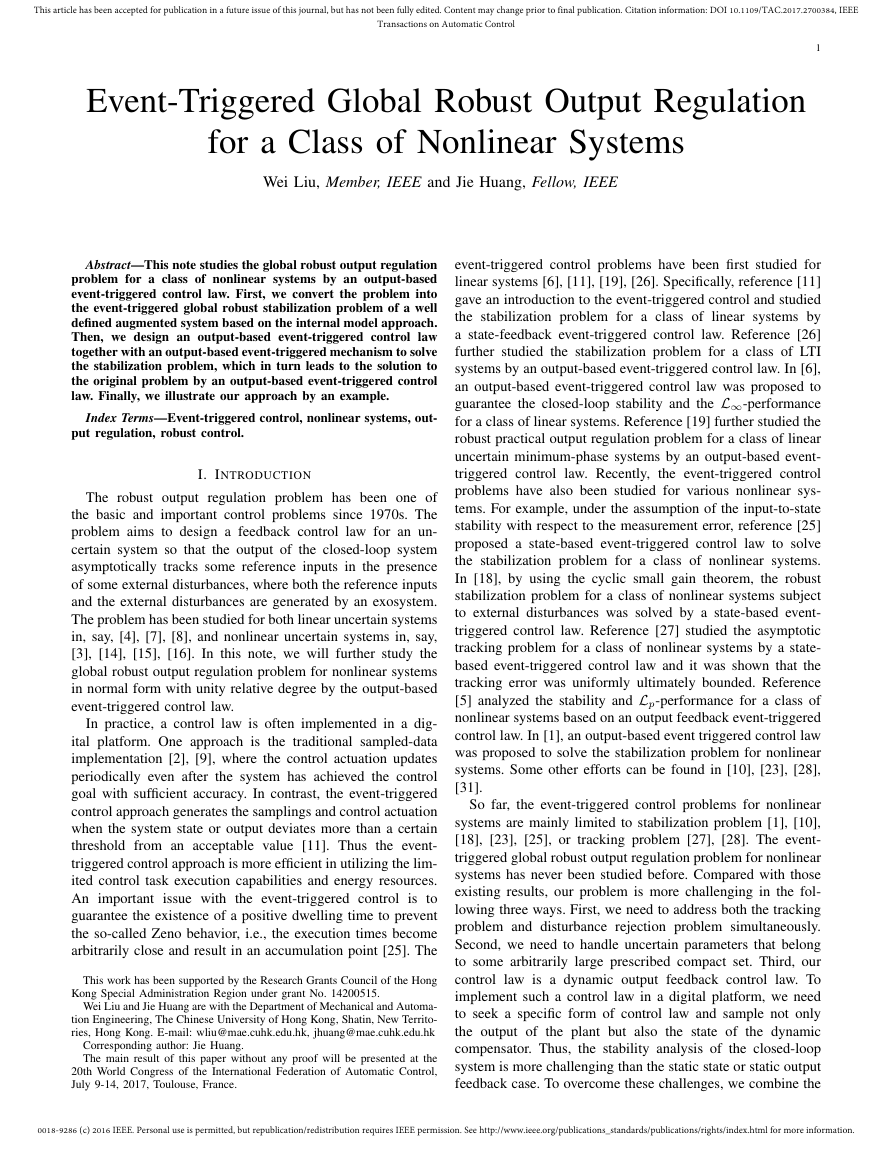
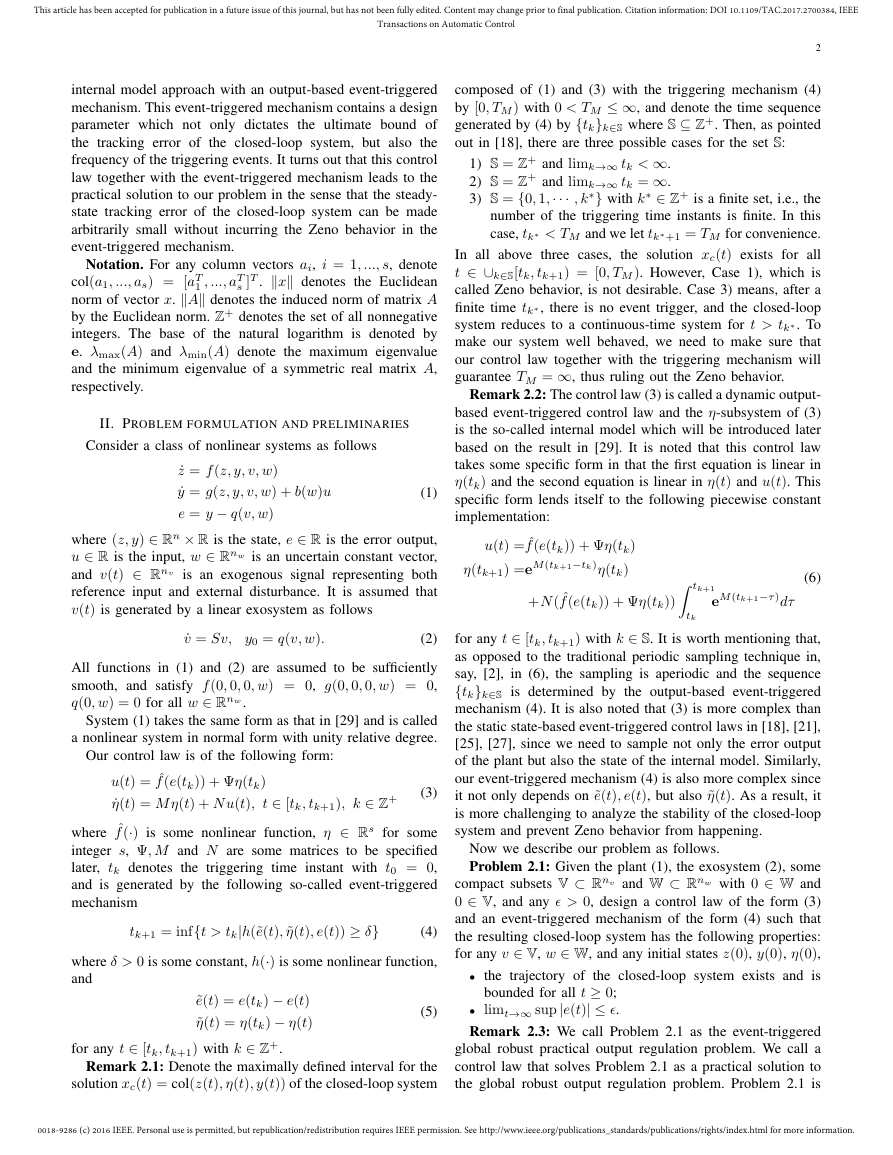
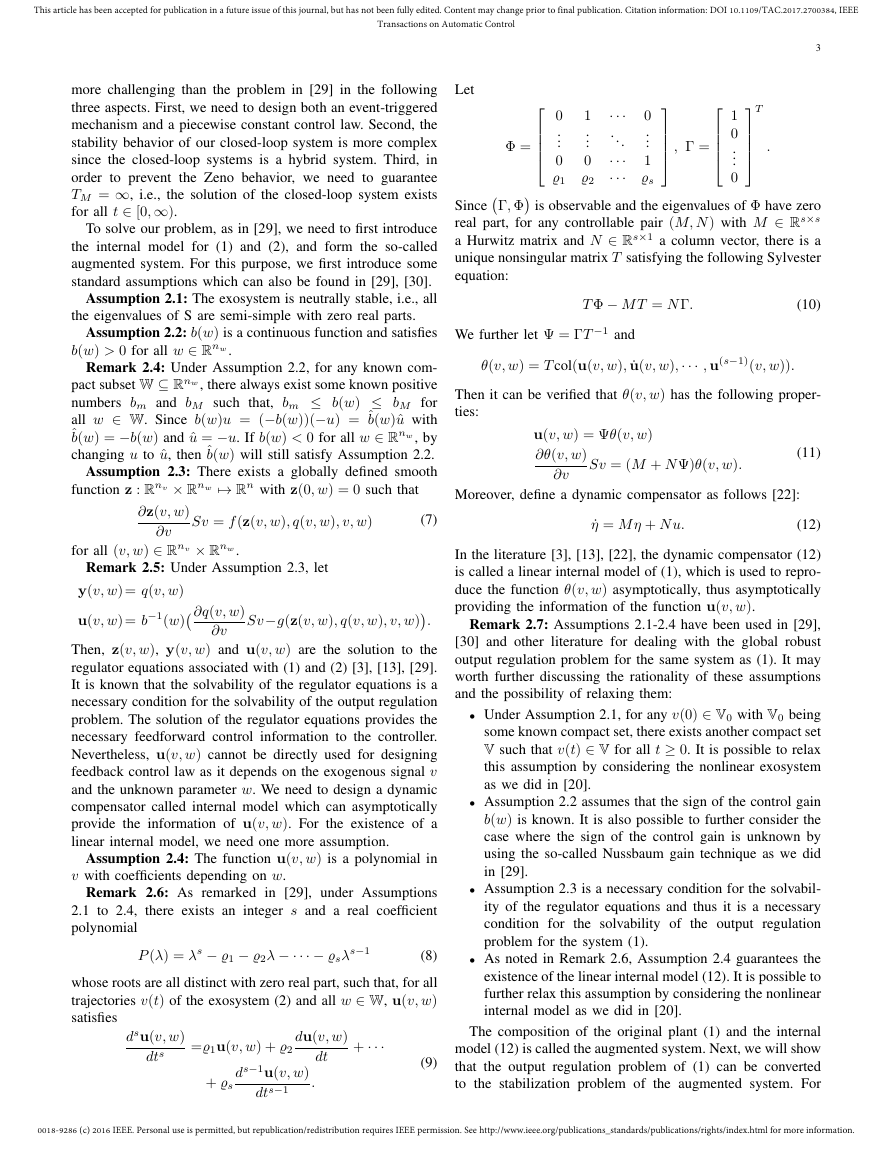
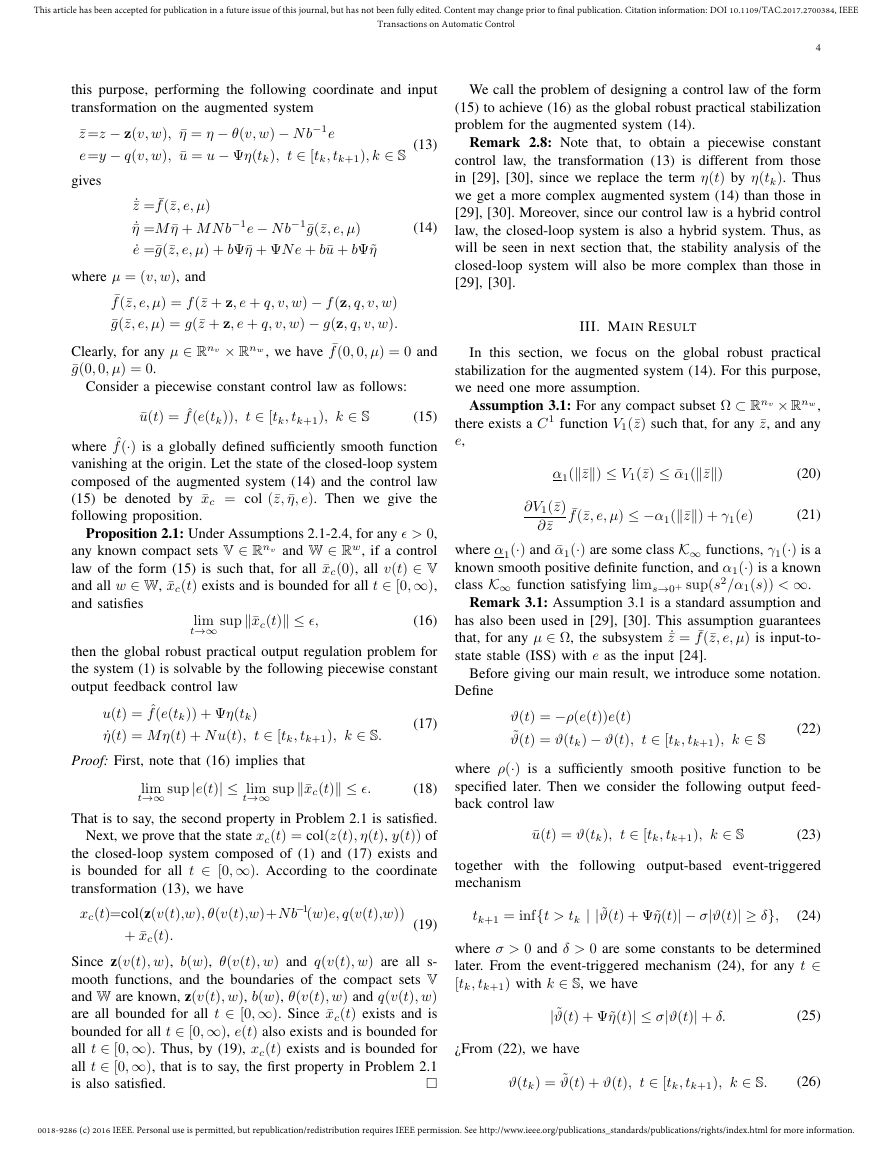
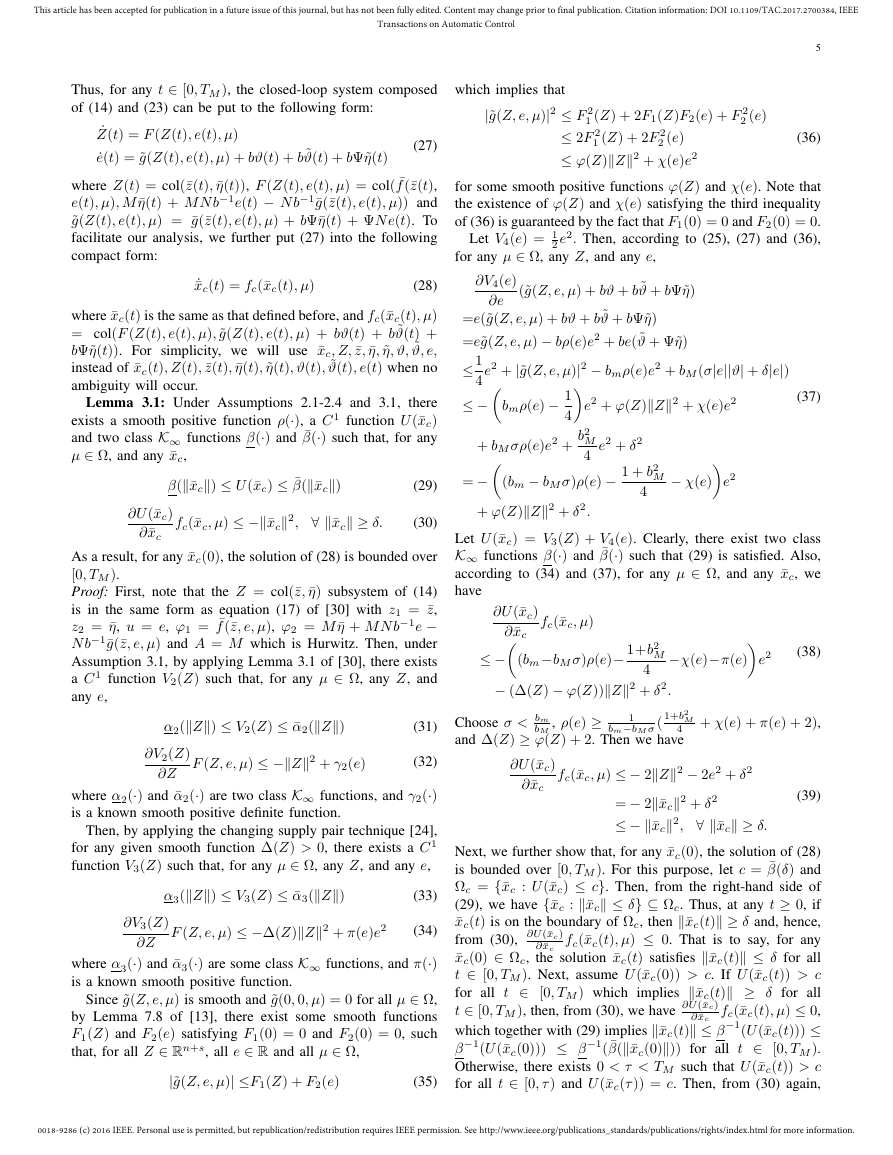
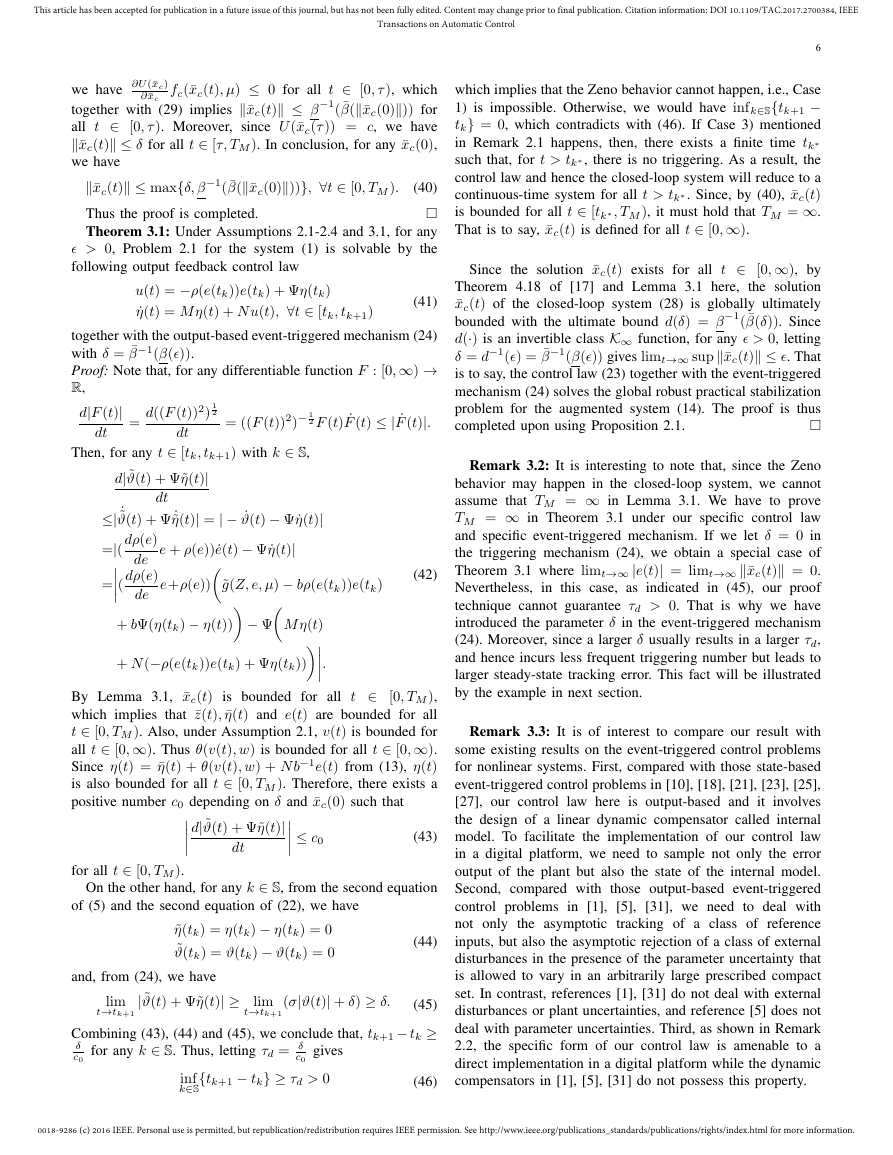
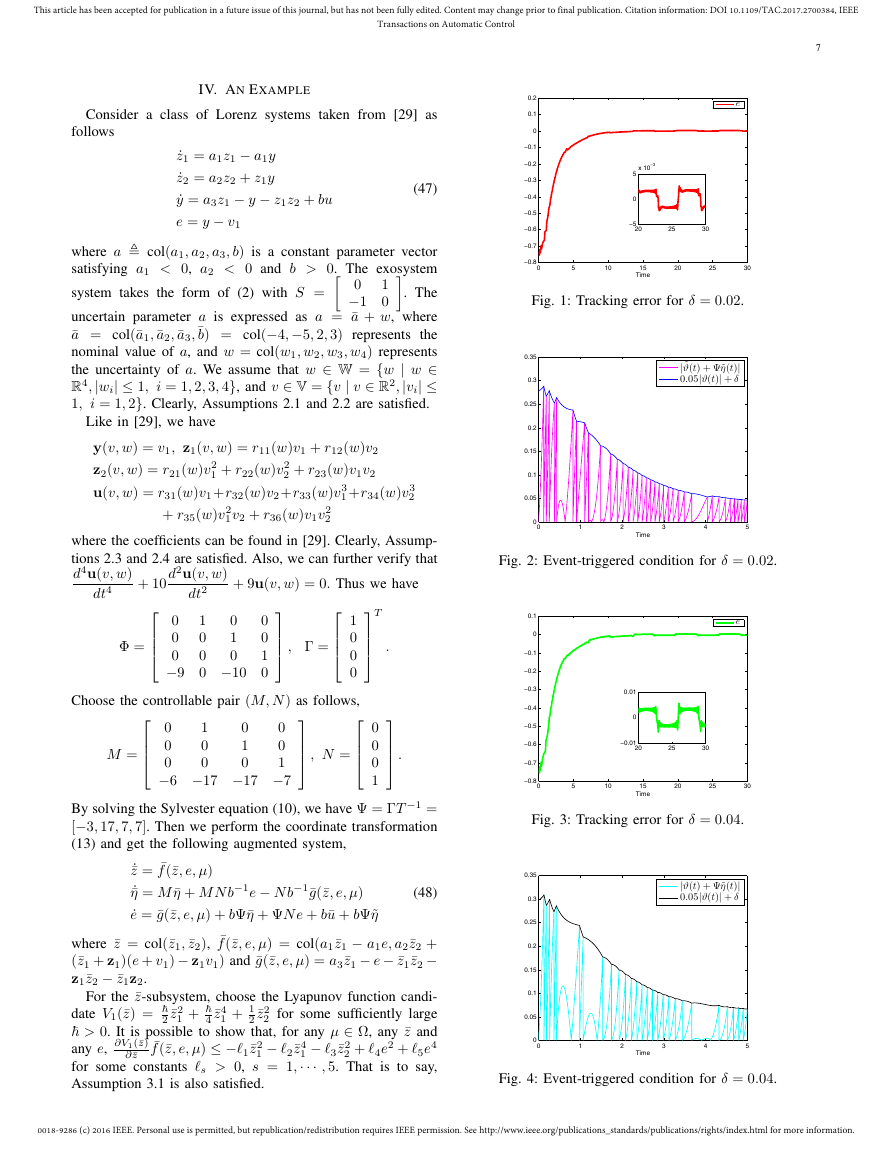
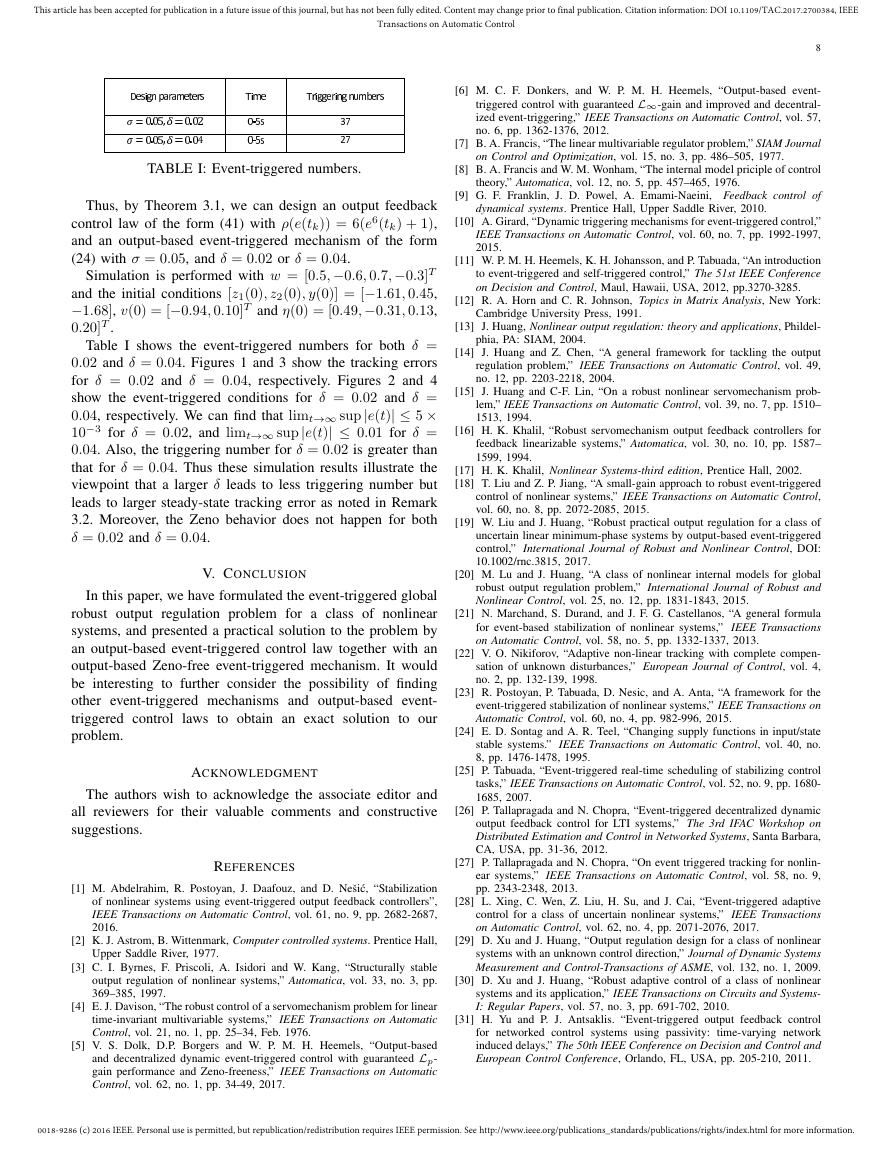








 2023年江西萍乡中考道德与法治真题及答案.doc
2023年江西萍乡中考道德与法治真题及答案.doc 2012年重庆南川中考生物真题及答案.doc
2012年重庆南川中考生物真题及答案.doc 2013年江西师范大学地理学综合及文艺理论基础考研真题.doc
2013年江西师范大学地理学综合及文艺理论基础考研真题.doc 2020年四川甘孜小升初语文真题及答案I卷.doc
2020年四川甘孜小升初语文真题及答案I卷.doc 2020年注册岩土工程师专业基础考试真题及答案.doc
2020年注册岩土工程师专业基础考试真题及答案.doc 2023-2024学年福建省厦门市九年级上学期数学月考试题及答案.doc
2023-2024学年福建省厦门市九年级上学期数学月考试题及答案.doc 2021-2022学年辽宁省沈阳市大东区九年级上学期语文期末试题及答案.doc
2021-2022学年辽宁省沈阳市大东区九年级上学期语文期末试题及答案.doc 2022-2023学年北京东城区初三第一学期物理期末试卷及答案.doc
2022-2023学年北京东城区初三第一学期物理期末试卷及答案.doc 2018上半年江西教师资格初中地理学科知识与教学能力真题及答案.doc
2018上半年江西教师资格初中地理学科知识与教学能力真题及答案.doc 2012年河北国家公务员申论考试真题及答案-省级.doc
2012年河北国家公务员申论考试真题及答案-省级.doc 2020-2021学年江苏省扬州市江都区邵樊片九年级上学期数学第一次质量检测试题及答案.doc
2020-2021学年江苏省扬州市江都区邵樊片九年级上学期数学第一次质量检测试题及答案.doc 2022下半年黑龙江教师资格证中学综合素质真题及答案.doc
2022下半年黑龙江教师资格证中学综合素质真题及答案.doc